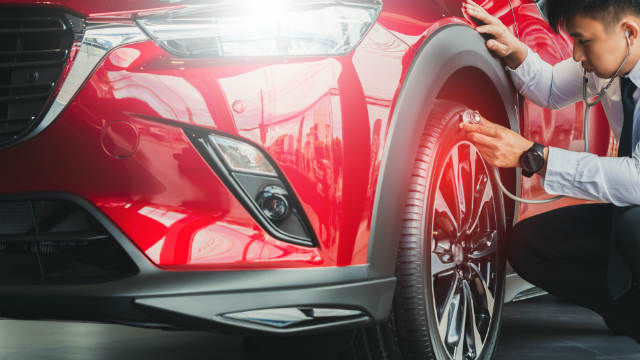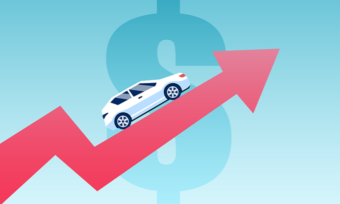Car Safety: 7 features to look for when buying a car

Most of us know about the importance of airbags and ABS brakes but what are some of the other safety features you should consider if you’re buying a new(er) car?
Car safety has come a long way since front seatbelts were considered a novel “optional extra”. In fact the use of seatbelts was only made compulsory in the early ’70s. Fast forward almost 50 years and safety features have become seriously high tech.
One of the first things to consider when buying a new car is its safety rating. You have probably heard of an ANCAP score, but what does it mean? It stands for the Australasian New Car Assessment Program. It’s an independent safety body that crash tests vehicles then awards them a rating between 0 to 5 stars indicating the level of safety they provide in the event of a collision. The more stars the safer your vehicle. To achieve the maximum 5-star ANCAP safety rating, a vehicle must achieve very high standards in all tests and feature advanced safety assist technologies.
→ Buying a car? Compare Car Insurance with Canstar
Here are some features that can enhance the safety of vehicles.
1. Electronic Stability Control (ESC)
Have you ever lost control of a car and fish-tailed? It’s frightening, not to mention potentially fatal. If this happens, ESC detects when tyres lose traction and takes steps to help the driver regain control, either by applying the brakes to spinning wheels or reducing power, or both.
ESC is such a brilliant safety advancement it’s mandatory on all new cars. Never turn off or disable the ESC button. If you’re buying an older car try to buy one with this important feature.
2. Lane departure warning
This technology lets the driver know if they’re literally “crossing the line”. Basically, it’s a camera-based system that monitors the car’s position by observing the line markings on the road. If a driver wanders outside their lane, an electronic observer will trigger an audible, visual or haptic warning and get them back on the right path.
A further advancement is Lane Keeping Assist – a proactive system which actually manipulates the steering to prevent drivers veering outside their lane. This technology feels a little “Big-Brother-Autonomous-Driving-freaky” at first. In some new cars, the feature is quite aggressive and can feel like you’re wrestling with your vehicle. But it’s a clever system designed to combat driver distraction and fatigue.
3. Active Cruise Control
Active Cruise Control (sometimes called adaptive cruise control) is a little like Lane Keeping Assist in that it takes a little getting used to. Once you have set Cruise Control, this nifty feature detects the distance and speed of the vehicle in front of you and maintains a safe following distance. For example, if you set Cruise Control to 100km/h, and the car in front of you slows to 90km/h, Active Cruise Control will override your setting and automatically slow your vehicle, too. And if the car in front speeds up again, your car will too. This is particularly handy for freeway driving. It’s worth noting that Active Cruise Control will not exceed your chosen speed though, even if the car in front does.

4. Tyre pressure monitoring
I know, I know; who checks their tyre pressure, right? It’s hard enough keeping fuel in the tank. But did you know properly inflated tyres add greater stability, handling and braking efficiencies? Conversely, under-inflated tyres can contribute to accidents in several ways: they reduce a vehicle’s handling ability, they increase the car’s braking distance and they can lead to blowouts. Pressure monitors detect when a tyre drops below the designated pressure and alerts the driver. There’s also an economical benefit to this technology as under-inflated tyres increase fuel consumption and shorten the tyre’s lifespan.
5. Pedestrian Auto Emergency Braking
Auto Emergency Braking (AEB) helps a car to independently brake, if a crash is imminent. But even this technology has been fine tuned to include a pedestrian system. It uses cameras and radars to detect vulnerable road users through their shape, movement and characteristics. The way a pedestrian moves in relation to the path of the vehicle is calculated to determine whether they are at risk of being hit. If the situation is critical, the brakes will be applied independently of the driver.
6. Reversing cameras
These things are a little like ATMs, mobile phones and Uber Eats: How did we ever exist without them? No more touch parking or neck adjustments required. On a more serious note, many reversing accidents can be avoided by employing this piece of tech. Using a monitor in the cabin and a rear-facing camera, this safety feature gives drivers a clear rearward view and can detect cars, people or objects in the way of a reversing vehicle.
Some of the newer systems provide impressive large, clear screens, parking guidance lines and even a bird’s eye view from above so drivers can see their car in relation to surrounding vehicles.
7. Auto dimming headlights
Have you ever been blinded by an oncoming car and its dazzling high beams? It’s a shocker. Road rules stipulate drivers must dip headlights to low beam when a vehicle coming toward you is within 200 metres or when driving 200 metres or less behind another vehicle.
Auto dimming headlights do this job for you. Sensors detect an oncoming vehicle and will switch off high beam when it’s safe.
Some of these safety advancements are mandatory but many remain optional extras. One of the first things to do when considering buying a new car is check its ANCAP ratings and ask about its safety features. After all, safety is one corner drivers should never cut.
About Elise Elliott
Elise Elliott is a journalist at WhichCar.com.au. She has been a journalist across the trifecta of TV, radio and print for more than 25 years.
Main image source: Loocid (Shutterstock)
Agreed value refers to when the policy allows cover for an agreed value. This is a sum that has been fixed after an agreement between the policy holder and the insurer prior to purchasing the policy.
Market value refers to when the policy allows cover for the market value of the car insured. This is generally what the car value would be prior to the insured event.








